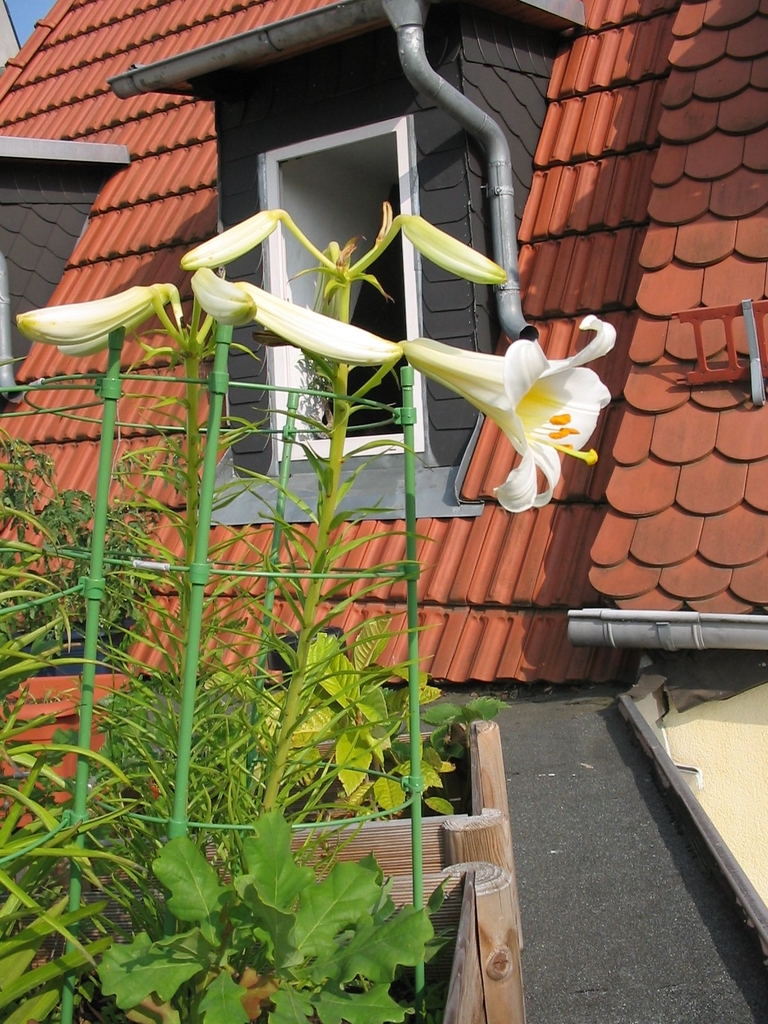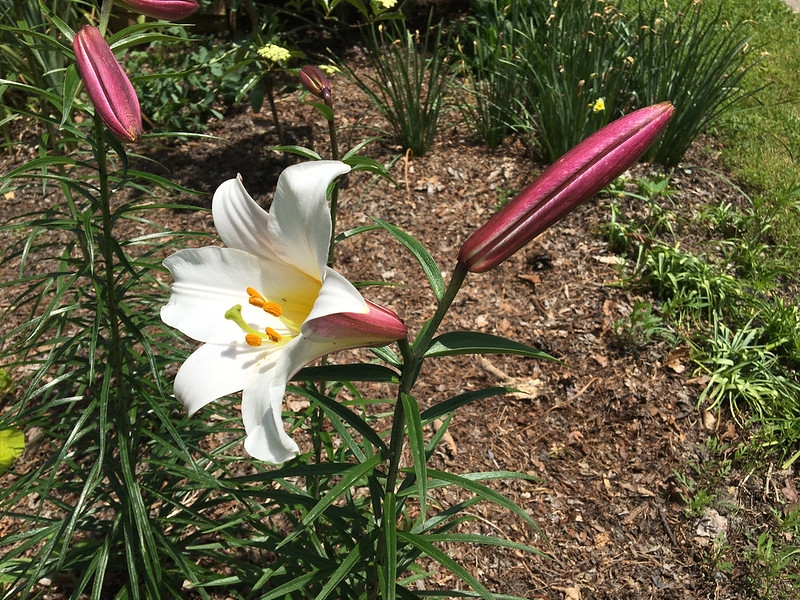Regal Lily Lilium regale
Other Common Name(s):
- This plant has medium severity poison characteristics.
- See below
- Description
-
The regal lily is a perennial bulb in the lily family (Liliaceae). It is native to the western Sichuan Province in southwestern China. In its native environment, it is only found within a 30-mile section of rocky cliffs in a narrow valley in the Hengduan Mountains. It was introduced in 1903 by Ernest Henry Wilson who was nicknamed “lily limp” due to the leg injury he encountered when he found it during a 1910 landslide. The genus name is Latin for lily, and the specific epithet means regal.
It prefers rich, organic soils, but is easily grown in any soil that is well-drained in full sun or part shade. It is drought-tolerant and flourishes with good moisture year-round. It is 3 to 6 feet tall and up to 2 feet wide. For an optimum display, plant at least three bulbs. Keep the roots cool with mulch. The bulbs can be divided and moved in the fall or winter. In areas with heavy soil and wet winters, plant the bulbs in early spring. For other areas, they can be planted in the winter. In hot and humid environments, plant the bulbs in raised beds to avoid fungal problems. The regal lily bulb is hardy. However, the early spring foliage is vulnerable to a late frost. It is advisable to stake the stems to prevent breakage by wind.
The regal lily is a long-lasting fragrant flower with large white trumpets. It is the earliest lily to bloom in July or August. Each stem can have 25 flowers. If you cut them, leave at least one-third of the stem. The plant is toxic to cats and can be fatal.
The bulbs can be grown in 3-gallon containers. They can be grouped in a perennial bed or near an area where their fragrance can be enjoyed. The regal lily can be mixed with annuals, perennials, and other lily species to cover the greenery after flowering. The mixed plants will also provide shade for the regal lily roots.
The regal lily received the Award of Garden Merit of Royal Horticultural Society in 1993.
Insects, Diseases, and Other Plant Problems: Lily leaf beetles, mites slugs snails and aphids attack the plant. Rodents, deer, and rabbits eat the plant (including the bulb).
VIDEO Created by Elisabeth Meyer for "Edibles, Bulbs, and Houseplants" a plant identification course offered in partnership with Longwood Gardens.
- Profile Video:
- See this plant in the following landscape:
- Cultivars / Varieties:
-
- L. 'Album'
Pure white flowers
- L. 'Album'
- L. 'Album'
- Tags:












- Cultivars / Varieties:
-
- L. 'Album'
Pure white flowers
- L. 'Album'
- L. 'Album'
- Tags:
-
-
Attributes:
- Genus:
- Lilium
- Species:
- regale
- Family:
- Liliaceae
- Life Cycle:
- Bulb
- Recommended Propagation Strategy:
- Division
- Seed
- Country Or Region Of Origin:
- Western Sichuan Province in south-central China
- Wildlife Value:
- Attracts bees, butterflies, and hummingbirds. It is a favorite of yellow swallowtail butterflies.
- Dimensions:
- Height: 3 ft. 0 in. - 6 ft. 0 in.
- Width: 0 ft. 9 in. - 2 ft. 0 in.
-
-
Whole Plant Traits:
- Plant Type:
- Bulb
- Herbaceous Perennial
- Poisonous
- Habit/Form:
- Erect
- Growth Rate:
- Medium
- Maintenance:
- Medium
- Texture:
- Medium
-
-
Cultural Conditions:
- Light:
- Full sun (6 or more hours of direct sunlight a day)
- Partial Shade (Direct sunlight only part of the day, 2-6 hours)
- Soil Texture:
- Clay
- Loam (Silt)
- Sand
- Soil pH:
- Acid (<6.0)
- Neutral (6.0-8.0)
- Soil Drainage:
- Good Drainage
- Available Space To Plant:
- Less than 12 inches
- NC Region:
- Coastal
- Mountains
- Piedmont
- USDA Plant Hardiness Zone:
- 4a, 4b, 5a, 5b, 6a, 6b, 7a, 7b, 8a, 8b
-
-
Fruit:
- Fruit Color:
- Cream/Tan
- Display/Harvest Time:
- Summer
- Fruit Type:
- Capsule
- Fruit Length:
- < 1 inch
- Fruit Width:
- < 1 inch
-
-
Flowers:
- Flower Color:
- Pink
- Purple/Lavender
- White
- Flower Inflorescence:
- Umbel
- Flower Value To Gardener:
- Fragrant
- Good Cut
- Long-lasting
- Showy
- Flower Bloom Time:
- Summer
- Flower Shape:
- Trumpet
- Flower Petals:
- 6 petals/rays
- Flower Size:
- 3-6 inches
- Flower Description:
- The 6-inch trumpet-shaped flower is pink-purple on the outside and white inside with a yellow throat. The outward facing flower blooms in July. Each stem can have up to 25 fragrant flowers. The flowers are usually more fragrant at night.
-
-
Leaves:
- Leaf Color:
- Green
- Leaf Feel:
- Rough
- Leaf Type:
- Simple
- Leaf Arrangement:
- Alternate
- Leaf Shape:
- Linear
- Leaf Margin:
- Entire
- Hairs Present:
- No
- Leaf Length:
- 1-3 inches
- Leaf Width:
- < 1 inch
- Leaf Description:
- There are numerous linear-shaped leaves scattered at irregular intervals along the stem.
-
-
Stem:
- Stem Color:
- Green
- Purple/Lavender
- Stem Is Aromatic:
- No
- Stem Cross Section:
- Round
- Stem Form:
- Straight
- Stem Surface:
- Polished
- Stem Description:
- When cutting the flowers, leave at least 1/3 of the stalk.
-
-
Landscape:
- Landscape Location:
- Container
- Patio
- Walkways
- Landscape Theme:
- Butterfly Garden
- Children's Garden
- Cottage Garden
- Garden for the Blind
- Pollinator Garden
- Design Feature:
- Border
- Mass Planting
- Attracts:
- Butterflies
- Resistance To Challenges:
- Drought
- Heat
- Problems:
- Poisonous to Humans
- Problem for Cats
- Problem for Children












